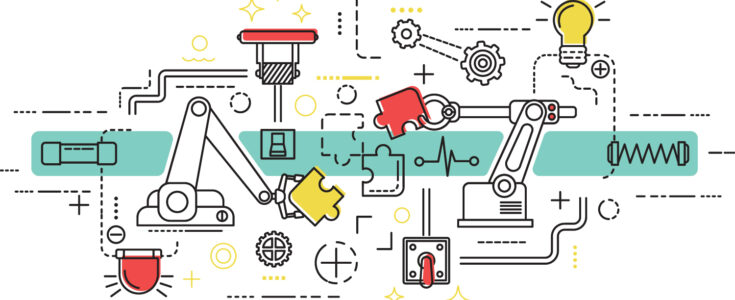
The 5 Stages of the Automation Maturity Model

By now you’ve probably heard of the automation maturity model, the path to hyper automation, or at the very least, bots. In fact, we’ve written about the automation maturity model before, but I wanted to take this opportunity to dig into what each level really looks like and what might motivate an organization to level up.
One of the most common questions we hear is where the next level of automation might fit into a specific business model, and this can feel like a tough question to answer from the outside. Here’s a deeper dive into the automation maturity model to help you determine whether you’re ready to talk to an expert about your automation needs or how to do more with the capabilities you already have.
Where We All Begin: Manual Operations
Most ideas and the organizations they grow into begin as words on a page and turn into a web of shared documents. This stage – manual operations – is as far as many companies get on the automation maturity model because not everyone needs automation.
And not having automation isn’t necessarily a bad thing. Even some major industry players with highly sophisticated products find that manual processes are the best way for them to execute core functions while meeting their compliance standards.
Think about national banks. Consider where they were in terms of customer service and online transactions a decade ago; any organization can go far with only manual operations, and that’s still an option. But today, the next level of automation is more accessible than ever before.
What We Mean by Integrated or Native Automation
Integrated or native automation may not even strike your leadership team as “automation.”
For example: If you rely on apps like Zapier to relay data from your API to your CRM, you’re using automation to complete this task and already leveraging a fairly mature approach behind the scenes.
To look at an even simpler example, if your organization relies on a CRM that’s integrated with your backend services to import and export customer data on a regular basis, you no longer simply rely on manual operations.
Most companies in business today are operating at this level of native automation, but many could benefit from adding a layer of rules-based instruction.
When You Might Make the Move to Basic Automation or Robotic Process Automation
The jump to basic automation, which relies on Robotic Process Automation (RPA), typically happens in one of a few scenarios:
- You’re forced to automate. This often happens during a merger, in which your organization’s data operations must be integrated with another. In this case, manual operations would be impractical and native automation isn’t sophisticated enough, but a bot could follow a set of rules to make the necessary updates.
- You’re faced with either a customer demand or an internal business demand that requires you to produce information faster than your team can manage.
- You’re scaling up and your legacy systems can’t make the leap forward with you. This is often forced by compliance needs at scale, but sometimes, you arrive at a point where your organization simply needs a more efficient way to get the data to where it needs to be within your systems and bots can carry that load.
The common thread in all three is the rise of a need for rules-based automation, rather than a simple integration.
Get Smart: Moving from Bots to Intelligent Automation
With RPA, your team just has to execute a bot and keep it running, but this may not be the end of your automation journey. If you find the need for a bot that can adjust its responses to emerging challenges, you may be ready to add intelligent automation to your systems.
For example, let’s say your RPA set-up works perfectly until you begin working with a new vendor that has entirely different data requirements. Perhaps you need to add them to your system for invoicing.
Say your bot, which previously recognized one type of invoices, now needs the capacity to durably recognize several types of invoices and to make decisions based on those distinctions. What you need is intelligent automation – a bot that’s not too smart, but one that’s smarter than all the information you could contain in a single book of rules.
It should be noted that for some companies, intelligent automation is a step on the way to hyper automation, but for others, it provides the support organizations need for the long-term. This is typically for one of two reasons:
- Industry presence: If intelligent automation puts your organization at the forefront of leaders in your industry, this may provide you the advantage you’re looking for at the level of investment you can afford.whether age, product, or skill. They have an advantage.
- No additional work requirements. Organizations that rely on intelligent automation typically have a good understanding of the data they’re using and they don’t need additional intelligence, market or internal. If that’s the case, there’s no need to invest in hyper automation, unless your needs change.
For Major Industry Leaders, the End Stage Is Hyper Automation
For major enterprise organizations that have the capital to invest in machine learning and the need to automate operations around massive amounts of data, hyper automation can be transformative and lock in their position at the forefront of innovation in their industry.
Hyper automation is the right move for large companies that are masters of their data because they can benefit from the conference of technology required for a specific, scaled implementation. Hyper automation may be thought of as an “end stage,” but it’s one that is highly individualized and strategically-driven, based on each organization’s needs.
And hyper automation is not for everyone – this is worth underlining. Many companies that are debating the merits of advancing their automation efforts should understand that hyper automation isn’t necessary for the majority of organizations, many of which could find their operations transformed by simply implementing RPA.
What’s important is finding the right level of automation to help you meet your organization’s near-term and long-term needs.
The Automation Maturity Model May Not Be Your Roadmap
The automation maturity model isn’t a roadmap that’s intended to lead everyone toward hyperautomation. In fact, the majority of small and medium-sized organizations will never have the need or the capital to support this level of automation.
But many businesses could benefit greatly from increased automation – even if only RPA – which is why it’s important for more business leaders to understand what’s possible.
Reach out to our experts to discuss what automation could look like at your organization.



![5 Ways Automation Humanizes the Workplace [Plus 1 Bonus]](https://s40886.pcdn.co/wp-content/uploads/2022/06/AdobeStock_411736181-scaled-1.jpeg)
